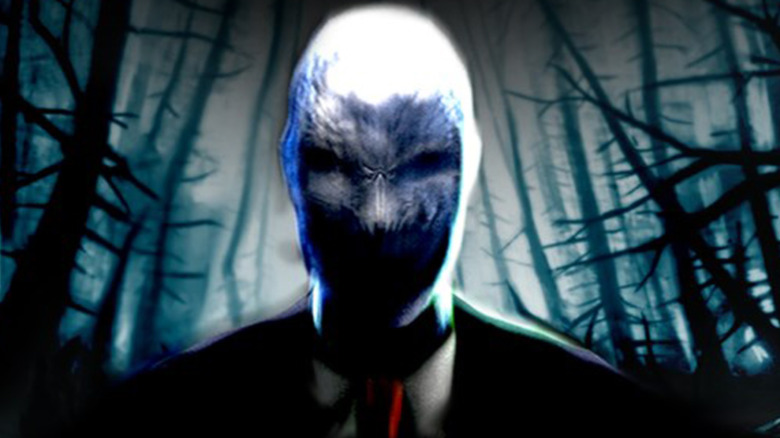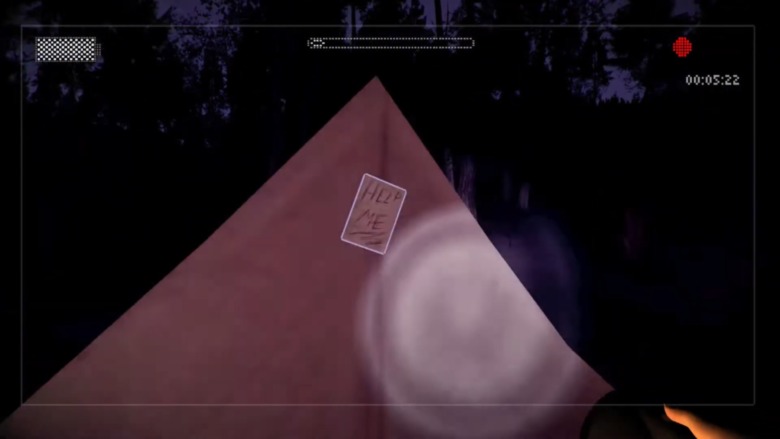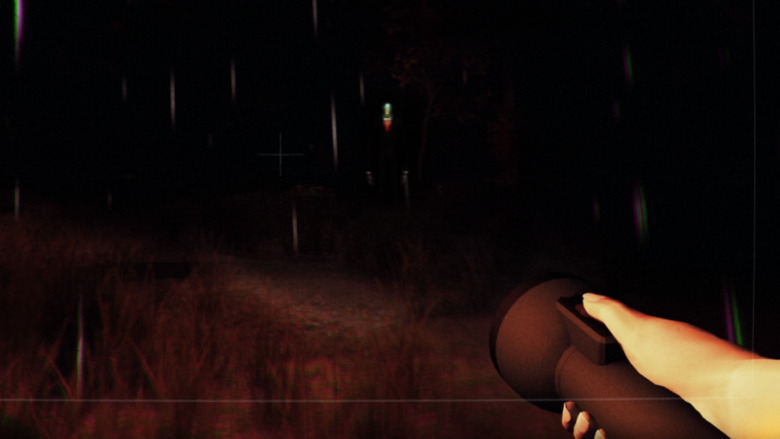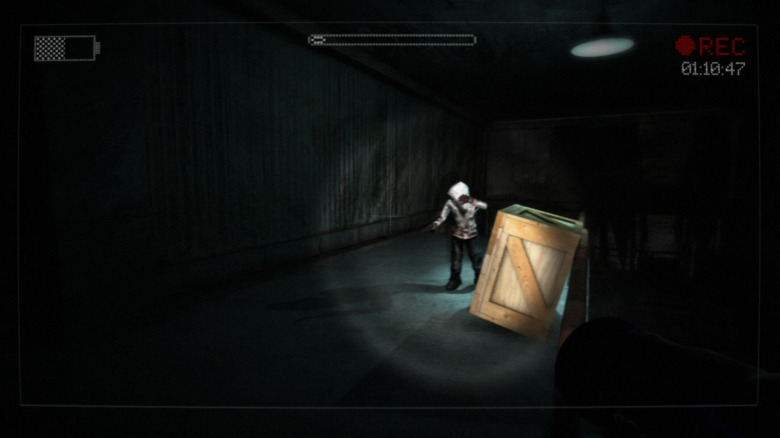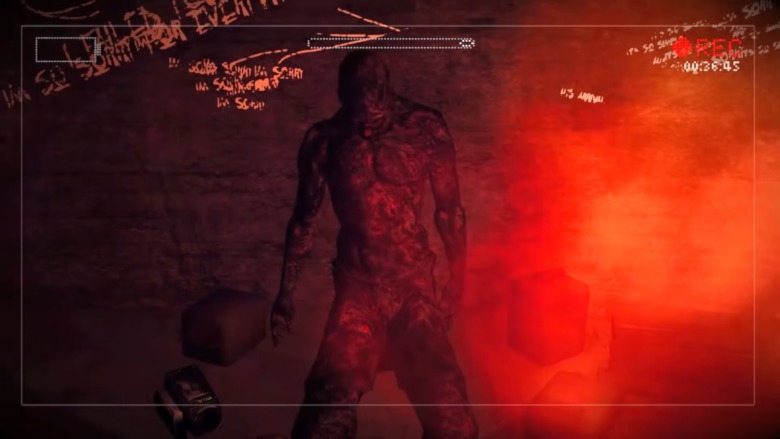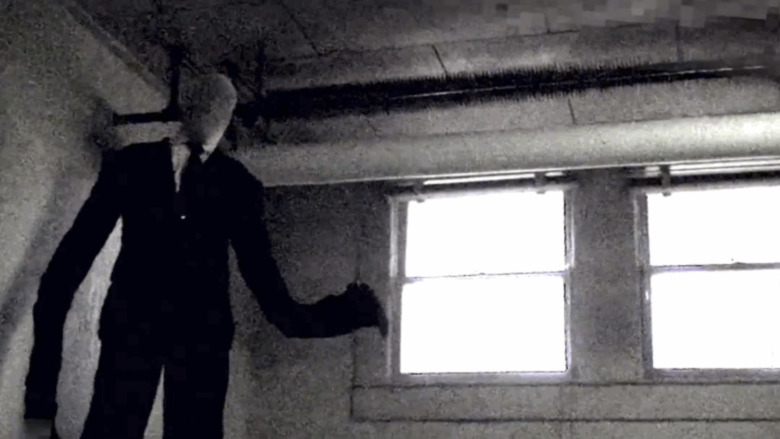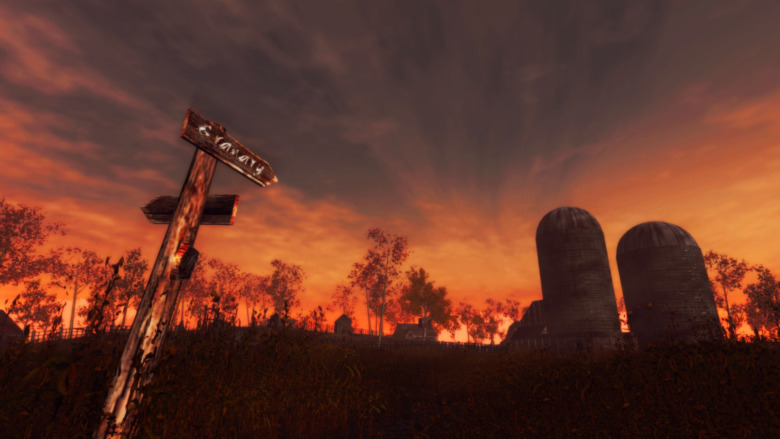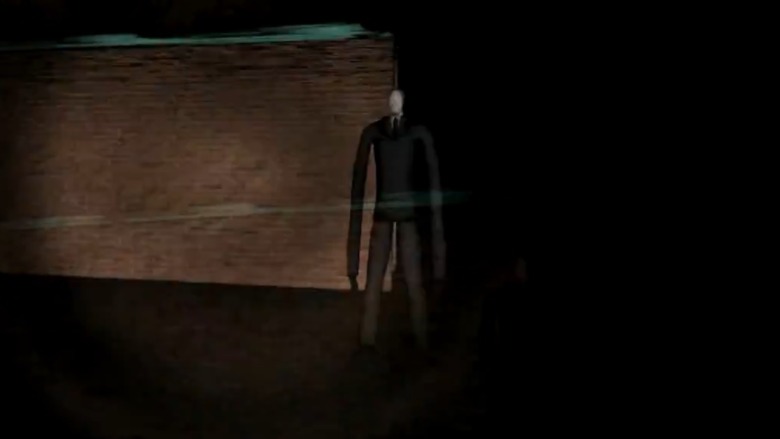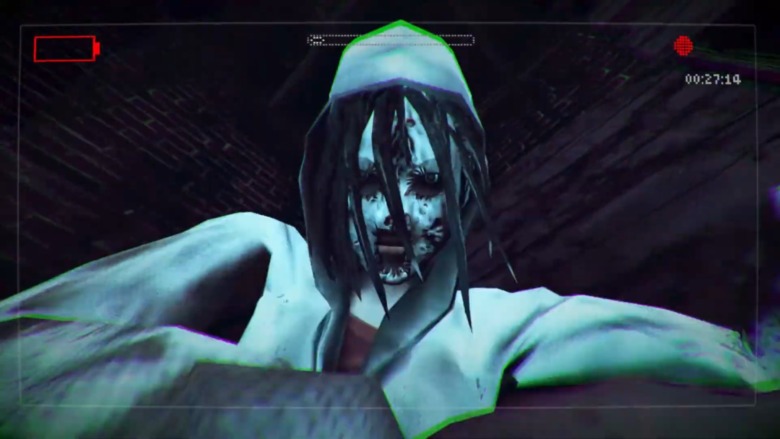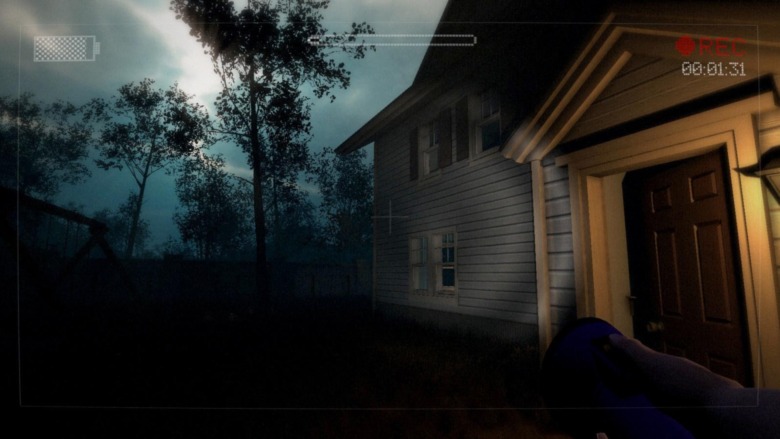Why We Should Never Have Been Allowed To Play Slender: The Arrival As A Kid
The late 2000s and early 2010s were a great era for video games. Arguably the biggest boon of the period was the sheer selection of memorable games to play; in addition to the standard AAA fare, a new movement was taking place in the form of an indie game renaissance. One of those less expansive games that left its mark on gamers was the freeware horror game "Slender: The Eight Pages," developed by Parsec Productions. The game puts players in the shoes of an unnamed protagonist who is being pursued by the paranormal Slenderman. At its simplest, Slenderman invokes a Lovecraftian madness in those who it stalks, breaking their grip on reality and making them primed to carry out its desires.
When word got out that the 2012 fright fest was getting a sequel just over a year after its original release, fans were eager to peek into the new abyss, uncertain of what might be peering back at them. Adding a harrowing plot to its predecessor's tension ratcheting mechanics, "Slender: The Arrival" packed in plenty of new scares. And that's exactly why so many gamers probably shouldn't have been playing the game as kids.
The game deals with repressed traumatic memories
In the game's opening minutes, Lauren arrives at her friend Kate's childhood home in an attempt to help her sell it, but she soon finds that Kate is nowhere to be found. In addition, the house is in disarray, with several letters from one of Kate's friends, CR, alluding to repressed memories the two seem to have of a traumatic event that the two experienced as children, as is shown in a story explanation video from Sneaky Peddler on YouTube. Reading the letters, the player will learn that CR has been going to doctors to deal with these memories and the trauma that the experience left him with.
While not everyone has traumatic memories that they have repressed, the thing about repressed memories is that a person with such memories wouldn't know of them unless something unearths them. The jump scares in "Slender: The Arrival" can undoubtedly be startling, but realizing there may be terrible things in your mind you can't remember? That may be even scarier.
The game blurs the line between mental illness and the supernatural
In CR's letters to Kate, he mentions that their shared hallucinations might be able to be treated by doctors. Several of the letters he sends to her contain advice from doctors on how to get their shared fear of Slenderman under control. As is shown in "The Arrival" and featured in Sneaky Peddler's YouTube video on the game's story, one letter details CR and Kate having a "shared traumatic event," which may have involved Slenderman, that caused them to have "the exact same hallucination."
Ultimately, this leads to the two trying to return to the site of their traumatic event in the woods, at which point they are separated, and more seemingly Slenderman-induced things happen to them while they're apart. CR finds Kate unconscious and takes her to a hospital. There, CR leaves a note saying that the doctors should help her.
The framing in the story makes delusions and hallucinations out to be all-too-real visions of the supernatural. For a kid playing this game, the idea that sometimes your imagination is actually a real danger may be particularly unsettling.
A loss of agency is a central theme
After "Slender: The Arrival" was updated, one of the more mysterious characters, the Chaser, had their identity revealed. In a new playable level, Kate tries to escape from Slenderman as he corners her in her house. She tries to flee in the woods, but Slenderman catches her and tells her, "I have plans for you Kate." HoodoHoodlumsRevenge explains the significance of this line on YouTube: essentially Kate has been turned into a proxy — a slave of Slenderman.
Another character that succumbs to the same fate is Charlie Matheson, Jr., who acts as another proxy. Both characters are forced to turn on friends and family in order to do the bidding of their creepily powerful master, regardless of how much they don't want to be a part of his deeds. Being forced to become a proxy and submit to the will of a supernatural horror like Slenderman, especially when it means hurting their family, is likely a frightening prospect for any kid.
It makes the player confront suicide as a character's only way out
Horror stories are not widely known for their happy endings and for how calm, wholesome, and unbothered characters are when they emerge on the other side of the story. "Slender: The Arrival" is no exception. Characters in the game face down an all-encompassingly grim fate with only the slimmest prospects of things not ending in utter disaster and misery. While some characters soldier on into the unknown, chasing that sliver of a chance, others choose to take a potentially more disturbing route.
Several characters in the game choose to take their own lives to escape the torment of Slenderman, and that can be a traumatic concept for kids to face. When the young Charlie Matheson, Jr. is kidnapped by Slenderman, his father, facing a life filled with unshakable visions of his son serving Slenderman, decides to take his own life. As Kate seeks help from her friend CR, his solution to stopping Slenderman is for the pair to douse themselves in kerosene and light a match. Suicide is an upsetting and traumatizing subject for anyone — facing an entity that some characters consider worse than death is a disconcerting notion for any child to face when playing video games.
If you or anyone you know is having suicidal thoughts, please call the National Suicide Prevention Lifeline at 1-800-273-TALK (8255).
It might serve as a gateway to more terrifying horror content
The developers of "Slender: The Arrival" brought in the creators of the popular YouTube horror series "Marble Hornets" to help consult on the game's story. In fact, the "Marble Hornets" production team is listed in the game's credits. "Marble Hornets," a veritable YouTube saga in its own right, contains more mature themes than "Slender: The Arrival," including violence and the use of cigarettes.
In addition, the identity of a character in "The Arrival," The Chaser, was a mystery until more content was added to the game in a post-release patch. Players at the time speculated that The Chaser was either "Maskie," a character from "Marble Hornets," or Jeff The Killer, the eponymous character from a widely circulated creepypasta. Jeff's internet-famous story is exceedingly violent and graphic in its description of said violence, though it does contain a few grammar errors that make it hard for most to take seriously. Just through those connections, there are several avenues for curious fans to find their way into more extreme and potentially frightening pieces of horror media.
It explicitly deals with children being the primary targets of Slenderman
As is shown in the expanded homestead level of the game, Slenderman's primary targets for abduction are children. In a video guide to getting all scrapbook items made by D A Game Guides, several items are examined within the estate historically inhabited by the Matheson and Hayes families' progenitors. The various documents point to a tendency of Slenderman creepily waiting and watching children when they are alone. Soon after his appearance, the children run away or otherwise disappear, presumably into the arms of the supernatural monster. This culminates in Charlie Matheson, Jr. being abducted during a family outing to a beach before the start of the game.
This is a part of the larger Slenderman mythos as it has developed online. Now a popular internet meme, Slenderman was created in a photoshop contest on the website Something Awful, where he was featured in a series of doctored photos. Both images portray Slenderman near and presumably preying on children. Some have celebrated the allusions to the character's roots as they played the game. However, these plot points have the potential to enhance the danger of the Slenderman in the eyes of young people who play "The Arrival," as they may feel even more threatened by the evil entity.
The jump scares may have been a bit too startling for some
Released as freeware, "Slender: The Eight Pages" took the internet by storm as the horror experience du jour. It was common at the time to sit a friend down to play the game while only telling them that they were playing a horror game while recording their reactions. It was especially fun to volunteer a friend who wasn't typically into horror experiences, meaning that their terror would be genuine and unexpected. Some people took the phenomenon even further, using the atmosphere built by the game to orchestrate real-life scares, as well.
When "Slender: The Arrival" was released, the developers behind the title included an HD remake of "Slender: The Eight Pages." This new version of the original game is presented as a bonus level, appropriately titled "Genesis." Since "Genesis" becomes accessible once "The Arrival" is beaten for the first time, it's not unthinkable that upon the new game's release, some people sat their friends in front of their computers for an updated, high definition scare.
The character models can be a bit grotesque for young audiences
When it came out in 2013, "Slender: The Arrival" looked decidedly past-gen in its graphical presentation. That isn't to say that the game isn't a vast upgrade over its free-to-play predecessor, "Slender: The Eight Pages" – it is. However, while the environments look alright, the character models are uniquely unpleasant to view. In fact, at the time of the game's release, PlayStation Lifestyle commented, "the graphics failed to impress at all."
Slenderman comes out looking the best since, presumably, players spend more time looking at him. Other characters, however, are not so lucky. Kate and The Chaser are both very undetailed models that move a bit stiffly.
What could send a chill down their spine might just be the most unnerving model in the game: Charlie Matheson, Jr. Kidnapped by Slenderman as a child, the grown Charlie appears to be an emaciated, desiccated corpse. Looking akin to a zombie, it's only natural for players who see him to ask, "What's wrong with you?"
The game might make kids feel unsafe in their own homes
One of the most well-explored subgenres of horror is the home invasion story. And while the majority of "Slender: The Arrival" takes place outside as Lauren goes on a quest to save her friend and rid herself of Slenderman's influence, there is an element of home invasion in the game, which is freaky in and of itself. Lauren's first location is Kate's abandoned childhood house, with the windows and doors open. As the game progresses, it is slowly revealed what led to Kate's absence.
Feeling the presence of Slenderman looming over her sole-occupant house, Kate begins closing all the windows and shutting the doors in the hopes of not letting the unnaturally tall terror inside. The empty, messy house found by Lauren seems to show that Kate was unsuccessful, showing that even locks can't protect against Slenderman. The sequence of Kate trying to secure her home is potentially frightening, in that it may be kids' first experience having their home (at least through gameplay) made to feel pregnable and incapable of shutting out the scariest of threats. Breaking that sense of security may be enough to put more than one kid on edge.

